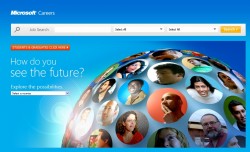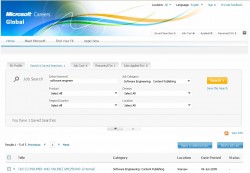 It’s not world peace, but Microsoft has managed to unite 97 countries in a single mission: Recruiting the top talent in the world.
It’s not world peace, but Microsoft has managed to unite 97 countries in a single mission: Recruiting the top talent in the world.
You’d think that wouldn’t be so hard, but when you start with (give or take) 150 different career sites and dozens of tracking systems and business units that built their own microsites because they felt their story wasn’t being told, well, it’s no surprise that for Margie Medd and Liz Friedman it sometimes felt as if they might never be done. (See our earlier story about this project, “Microsoft is Building An Ambitious, New Global Recruiting Site.”)
But Monday Microsoft unveiled its new career site that for the first time since the company went global makes it possible for someone in Moscow, Idaho to search for a job in Moscow, Russia, Redmond, Washington, Mumbai, and London all at the same time.
Eliminating the clicks, says Friedman, group marketing manager, was one of the functional goals of the project she helped manage. Being real, as in using real Microsofties and not stock images, and helping potential candidates get around the site they way they want, were other objectives.
From a corporate recruiting standpoint, Medd, director of employment branding, outlined a set of goals for redesign that were equally as ambitious: present a consistent global brand message, tap the global talent market in a way that allows a jobseeker in Moscow, Idaho, or one in Moscow, Russia, to fill a position anywhere Microsoft has a fit, and to make the candidate experience simple, comfortable, and direct while having enough of a “wow” element that candidates were excited by what they see.
“The message we wanted to send is that we want to truly hire the best talent from around the world,” Medd says. Reducing costs and making it quick and easy to update the content on the site were additional goals, but the driver was telling the Microsoft story.
That piece of the relaunched Microsoft career site is still being implemented. A new content management system is days away from being in place. When it is, the average time it takes to update editorial content on the site (as separate from the job postings and descriptions) will go from weeks to hours.
 The jobs listings, the transactional part of the site as Medd and Friedman describe it, powered by a new SAP system, is the piece that is now in place for the 97 countries. Jobs are in English, the company’s standard. Where local regulations require or culture dictates, jobs will also be in the local language.
The jobs listings, the transactional part of the site as Medd and Friedman describe it, powered by a new SAP system, is the piece that is now in place for the 97 countries. Jobs are in English, the company’s standard. Where local regulations require or culture dictates, jobs will also be in the local language.
From the first page of Careers.Microsoft.com to the last, job searching is prominent and primary. Every page on the site has a search box. Conduct a search and it’s automatically stored without a candidate having to give up a single personal detail. If you do want to save things from session to session, then a simple registration is required. But if you would rather not, candidates can search, create a resume (or several) and apply for one or a hundred jobs without creating a permanent record. (Of course recruiters and hiring managers will have a record.)
Two years ago, when the project was in its infancy, focus groups told Medd and Friedman that three things were critical: search and apply for jobs was number one. Knowing what to apply for in a company with 100,000 employees was next on the list and third was specific information on the company and the job.
That’s why the job search is everywhere on the site. And that’s why the navigation bar has only three main channels: Apply Now, Find Your Fit, and Meet Microsoft. The content for the latter two channels will grow over the next several months, although the core pieces are in place. Microsoft’s most popular recruiting features – Hey Genius, View<my world>, and Microspotting — will stay and retain their own separate identification, though one or two might be folded into the career site over time. The irreverant “Day of Microsoft Perks” video was preserved and is a part of the channel that talks about the company’s benefits package.
In as broad and ambitious a project as this was, Medd and Friedman both said the most daunting part was creating a visual expression for the company and the site that conveyed the same impression everywhere in the world. The first version, using “watercolor images” got a thumbs-down from markets outside the U.S. The “truthkeepers out there,” as Friedman described her international focus group, thought it didn’t convey the professionalism and energy of the company.
All along the way, the 10-person team had to accommodate multiple interests and multiple stakeholders.
That effort is apparent from the very first page, with its world of diverse faces, to the pictures on every page, all of them actual Microsoft employees. Even the pulldown menus convey the sense of Microsoft as a global company. The first country listed is Algeria, not the U.S., as is typical for most U.S. companies.
It’s too early to tell what the impact of the redesign is. In fact, not even all the countries have yet been rolled out. That will occur over the next several months as the content management system comes online and local information is created to supplement the core Microsoft editorial. Monday’s launch was of the universal jobs search and the core content. The U.S. and U.K. sites also went live then. Japan is to follow soon. It will take until next spring to complete the rollout.